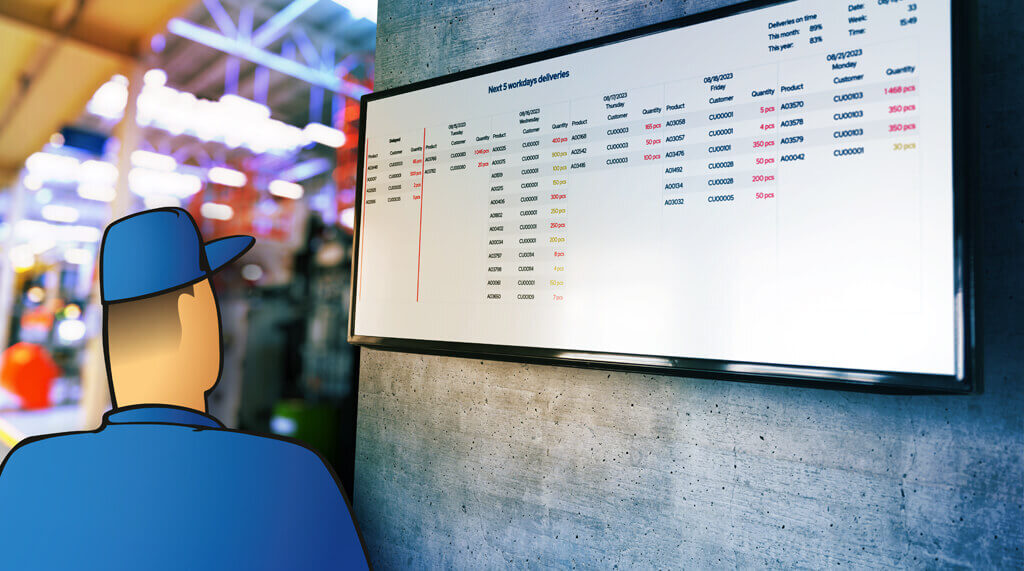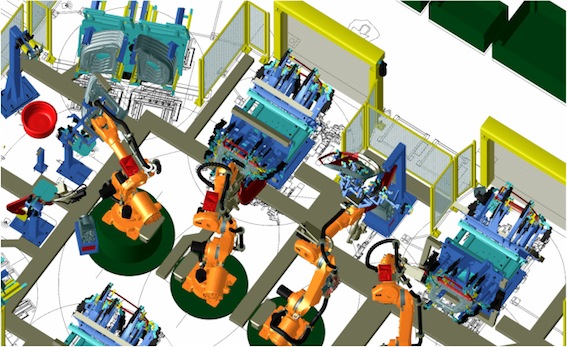Shop Floor Management and Control Practices for Small Manufacturers
Shop floor management and shop floor control are essential for any business that adds value to physical goods in-house. In this post, we go over shop floor basics and look at how good shop floor management and control practices help increase production efficiency.

You can also listen to this article:
What is a shop floor?
A shop floor is the area of a manufacturing facility where materials undergo processing in workstations to have value added to them. Basically, it is the central area of a manufacturing plant or a factory where production takes place. Raw materials inventory is taken there for processing in workstations, and finished goods or assemblies are moved out of it into shipping or the warehouse.
Shop floors vary a lot in their constituents and layout, depending on manufacturing type and the specific needs that companies have for their workstations, processes, and personnel. Still, there are some commonalities, as well as shop floor management and control aspects that any manufacturing company should look into when setting up shop.
What is shop floor management?
Shop floor management, or SFM, is the process of developing and managing practices to increase the efficiency of the shop floor. This includes many things like optimizing the shop floor layout and product routings, managing employee movements and payroll reporting practices, controlling the flow of goods to and from the shop floor, optimizing production processes, implementing automation systems, etc. Shop floor management includes both the initial planning phase of the shop floor as well as the day-to-day activities of the shop floor manager.
The shop floor is more than just a physical space for workstations. It is the central integrated hub of a manufacturing operation. SFM therefore also affects and informs other key aspects of manufacturing like production planning and scheduling, inventory management, accounting, and even back-office functions.
Many approaches to shop floor management are loosely based on objectives that align with the 4P Management Model – Philosophy, Process, People, and Problem-solving, a subset of the Toyota Production System. The 4P model underscores key areas that shop floor management should focus on to increase operational efficiency – it aims to develop efficient business processes, minimize the 8 wastes of Lean manufacturing, bring about the optimal use of human effort, and implement continuous improvement practices.
Shop floor management objectives
A day on the shop floor involves many activities for the shop floor manager, including but not limited to:
- Receiving production orders and scheduling them based on deadlines and importance.
- Doing daily rounds, conducting team meetings, and facilitating effective communication between supervisors and shop floor workers.
- Planning and controlling the sequence of operations and the flow of materials.
- Managing workstations and ensuring that each one has the resources and instructions to complete its tasks.
- Monitoring order progress, identifying bottlenecks and deviations, and adjusting production schedules as necessary.
- Conducting quality checks and documenting the results.
What is shop floor control?
Shop floor control, or SFC, refers to a range of processes and methods aimed at gathering, tracking, and reporting data flows throughout the shop floor. The chief objective of SFC is to gain a tactical overview of the shop floor and its management practices. SFC’s key applications are order management and scheduling, data entry, traceability, and reporting. Circumstantially, however, it also involves capacity requirements and resource planning, material availability, documentation and data logging, work process and routing optimization, etc.
Shop floor control essentially begins as the production planning phase ends. It forms the crux of the digital control and monitoring of production, including work order and process reporting, status reporting, statistics, and continuous performance and quality monitoring.
Much like shop floor management writ large, the utility of well-implemented shop floor control systems reaches far beyond the physical factory floor. By analyzing real-time data on manufacturing workflows and production status reports, SFC systems form a central part of the whole manufacturing operation and provide multi-directional data streams for use in purchasing, inventory management and control, dispatch and shipping, WIP inventory, cost accounting, etc.
Components of a shop floor
Regardless of the precise nature or manufacturing requirements of a company, every shop floor will usually have some common elements. Workstations form the core of the manufacturing process. Here, raw materials are shaped, cut, assembled, and modified in various ways. Any shop floor will also include pathways for moving raw materials and finished goods to and from the manufacturing or assembly area. While goods are generally stored in warehouses, shop floors may also have some storage areas for WIP inventory. In more complex workflows or multiple shop floor setups, decoupling points can also form a distinct area of or between shop floors.
Quality control zones are another pivotal part of shop floors. Here, routine checks are conducted to ensure that the products meet industry standards. Most shop floors also feature a dispatch or shipping area where finished products are prepped and sent off for distribution. Finally, many shop floors, save for completely automated ones, also include equipment and tool storage, rest areas for employees, as well as dedicated spaces for ancillary machinery and infrastructure.
Shop floor design and layout considerations
Despite many commonalities, the way shop floors are laid out or what they consist of can differ significantly based on the needs of the manufacturing process. For instance, a job shop floor that handles customized, one-off products in an assemble-to-order workflow, will likely have a more flexible, easily reconfigurable layout. In contrast, a mass production line is typically characterized by a more rigid, streamlined design, such as a linear or U-shaped assembly line, to facilitate the quick and efficient production of identical items.
Each layout is designed to optimize the specific kind of work being done. This underlines the importance of carefully planning out a shop floor to best serve specific manufacturing needs. Here are some recommendations when designing or rearranging the shop floor:
- Map out the company’s requirements for manufacturing, handling, inventory and personnel movements, and traceability in detail and in cooperation with all relevant departments.
- Plan and execute a well-thought-out layout with clearly designated areas, logical adjacency, and due attention to details like health and safety equipment placement. This helps to raise employee productivity and streamline the overall flow of goods, increasing production efficiency and throughput.
- Clearly designated pathways with sufficient dimensions, taking into account the number of employees or mobile machinery, ensure optimal operation. This helps to shorten lead time and minimize bottlenecks and physical constraints. Factor in enough space around workstations, quality management activities, and maintenance work. Leave additional room for future expansion if the company is planning to scale.
- Designate places or storage rooms close to relevant workstations for tools and handheld machinery. This way, workers have faster access to equipment, the overall workspace is decluttered, and loss of property is minimized.
- Delve into KPIs like stock turnover rate, cycle time, capacity utilization, etc., to gauge the ideal stock levels that the shop floor needs to be replenished with. Aim for minimal inventory storage within the shop floor and consider standardizing stock movements to and from the shop floor, where applicable.
Shop floor production methods
Shop floors have some distinct differences depending on the type of production method that a manufacturer utilizes.
- Discrete manufacturing. This type of manufacturing method produces distinct units that are mostly assembled from a wealth of components and sub-assemblies. The shop floor layout usually needs to accommodate many different workstations which are set up in either sequential, parallel, or a combination of different layouts before the final assembly stage. Cellular manufacturing is often utilized to partition the assembly stages and maximize space.
- Process manufacturing. In process manufacturing, goods are created through mixing, boiling, blending, or otherwise joining raw materials together in a “process”. Because raw materials need sequential processing from basic states to more refined ones, process manufacturing workflows don’t usually utilize parallel execution. This makes the shop floor layout almost always linear. Process manufacturing can output goods in either batches or a continuous flow.
- Mass or repetitive production. In this type of manufacturing workflow, large volumes of identical goods are produced through meticulously planned and mostly automated production lines. These need a high level of integrated production and quality control as the output needs to be fast and provide consistent quality. The layout of mass production shop floors is mostly linear with sequential workstations conjoined by conveyor belts. They must also provide ample room for quality control engineers and production managers to oversee the manufacturing process, however.
Read more about discrete and process manufacturing.
Setting up a shop floor management system
Setting up a robust Shop Floor Management System (SFM) involves more than just selecting the right software or putting a team in place. It’s about creating a synergistic environment where human skills and technological aids form a unity with lean manufacturing principles.
A critical first component is outlining the specific objectives that an SFM system needs to achieve. Whether it’s improving workflow efficiency, minimizing machine downtime, enhancing product quality, or all of the above, having clear goals will dictate the operational guidelines of setting up as well as the metrics that need to be monitored. This preliminary stage often involves cross-departmental collaboration, ensuring that the SFM system aligns with the broader organizational strategies and objectives. For gauging shop floor performance once the system is humming away, inputs on baseline data should also be drawn up and collated retrospectively.
The second crucial phase is the selection of the right tools that will form the backbone of the SFM system. In modern manufacturing, leveraging advanced shop floor management and control software can drastically improve a company’s ability to increase the accuracy and efficiency of its shop floor operations. These systems offer functionalities that enable planning, scheduling, real-time tracking, and robust reporting while also leaving room for scalability. The requirements for a smaller shop floor may significantly differ from a medium-sized one a few years down the line.
However, technology is not everything. Continuous improvement stands as perhaps the most crucial facet of effective SFM. This goes beyond carrying out periodic audits against KPIs and implementing iterative refinements based on them. It also involves fostering an environment of proactive problem-solving where issues are both systematically identified and analyzed to prevent recurrence. Employee training is another cornerstone, ensuring that everyone from line workers to managerial staff is well-versed in SFM protocols, capable of using the SFM system optimally, and providing feedback for ongoing improvements.
Shop floor control systems
As we have seen, shop floor management encompasses a range of procedural, technological, and company culture-related aspects. Shop floor control systems (SFCS), on the other hand, are fundamentally anchored in software in the modern manufacturing landscape. While procedural standardization still exists like defining when an employee should interact with the system for reporting, shop floor control software is the digital nerve center of shop floors where data collection, analysis, and real-time monitoring take place. An SFCS is usually integrated into manufacturing software like an MRP system or manufacturing execution system (MES).
Shop floor control systems work by gathering real-time production data from various shop floor operations and funneling them into centralized dashboards. This includes everything from machine efficiency and real-time inventory level tracking to workforce productivity and labor reporting, etc. With accurate data, managers can make better decisions faster and have much greater real-time visibility of the manufacturing effort.
The core tenets of a SFCS include:
- Communication. An SFCS enables efficient communication between all connected departments and is integrated within the larger manufacturing ERP or MES.
- Data management. All the data related to shop floor operations is centralized in an SFCS, including functionalities for real-time monitoring and logging of business data.
- Data processing. SFCS handles the computation and analysis necessary to transform raw data into actionable insights.
- User interface. SFCS compiles the data into intuitive, user-friendly dashboards and interfaces that allow easy interaction with the system for monitoring and reporting. They usually have distinct modules with dashboards for production managers and internet kiosks for shop floor workers. The best cloud-based solutions are also accessible through any internet-enabled device like smartphones and tablets.
Advantages of digital shop floor management and control systems for SMEs
To end this article, here is a look at the key advantages that effective shop floor management and control systems can bring to small and medium manufacturing companies.
- Streamlined operations and higher efficiency. Shop floor management software unifies and standardizes operations and communication. This makes shop floor activities more predictable and manageable and increases the productivity of staff.
- Error minimization and quality improvement. SFC systems substantially reduce human errors in workflows. Whether it’s the calculation of machine time, man-hours, or payroll, digital accuracy ensures fewer mistakes, more accurate books, and better overall product quality.
- End-to-end visibility and empowered management. With a well-implemented SFCS in place, management can get a real-time view of everything happening on the shop floor. This total visibility enables close monitoring of operations and activities, resulting in more informed decision-making.
- Proactive problem-solving. Healthy shop floor management practices coupled with digital solutions enable notifying team members of potential issues before they become major problems. This preemptive approach saves time and resources, reducing operational vulnerabilities and helping to mitigate any data losses.
- Data-driven decision-making. With an SFCS, real-time, quantifiable, and actionable data is constantly available to managers. This not only simplifies daily decision-making but also drives the strategic ambitions of the manufacturing operation.
- Resource optimization. The proper planning and scheduling of shop floor activities also maximizes resource usage. By providing an overview and statistics of production performance, shop floor management tools help to optimize inventory movements and supply chain operations.
- Paperless manufacturing. Operating in a paperless environment is proven to be more cost-efficient and increase systematic performance. Eliminating paper reduces clutter, simplifies audits, enhances information retrieval, and standardizes work processes.
Ultimately, these advantages converge to decisively improve the operational efficiency and revenue of small and medium manufacturing businesses. With modern, affordable cloud-based solutions readily available, implementing a digital shop floor management system brings rapid improvements to the shop floor and helps to increase a company’s profitability.
Key takeaways
- Shop floor management (SCM) is the process of developing and managing practices to increase the efficiency of the shop floor. This includes optimizing the shop floor layout, managing employee movements and reporting, controlling the flow of goods to and from the shop floor, etc.
- SFM affects and informs many key aspects of manufacturing like production planning and scheduling, inventory management, and cost accounting.
- Shop floor control (SFC) refers to a range of processes and methods aimed at gathering, tracking, and reporting data flows throughout the shop floor. It includes work order and process reporting, status reporting, statistics compiling, and continuous performance and quality monitoring.
- A shop floor control system (SFCS) is integrated software that gathers and tracks real-time production data from various shop floor operations and funnels them into centralized dashboards. It combines powerful data management with accessibility, reading and analyzing input data to produce actionable insights.
Frequently asked questions
A shop floor management system (SFM) is a set of processes and tools aimed at increasing the efficiency and productivity of a manufacturing facility’s shop floor. It covers aspects like layout optimization and employee scheduling and provides actionable insights through the real-time monitoring of manufacturing processes.
Improving shop floor management involves setting clear goals, using real-time data for decision-making, and investing in advanced SFM software. Implementing training and continuous improvement practices are also essential for fine-tuning operations.
Shop floor control (SFC) enhances productivity by providing real-time tracking, reporting, and scheduling of work processes. This leads to improved inventory control, streamlined operations, and increased overall efficiency on the shop floor.
You might also like: Production Routing – Definitions, Tips, and Examples




